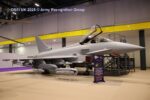The Royal Canadian Navy (RCN) has chosen the Schiebel CAMCOPTER S-100 vertical take-off and landing (VTOL) unmanned aerial vehicle (UAV) as part of its Intelligence, Surveillance, Target Acquisition and Reconnaissance (ISTAR) modernization program. Integrated by MDA Space as the prime contractor, the S-100 will provide advanced maritime ISR capabilities to support naval operations in complex littoral and open-ocean environments.
RCN’s Maritime ISTAR Requirements Drive UAV Selection
The RCN’s ISTAR initiative is part of a broader effort to enhance situational awareness and decision-making across its surface fleet. The program seeks to integrate persistent airborne surveillance assets capable of operating from ship decks under challenging weather and sea conditions. Key requirements include:
- VTOL capability for shipborne launch and recovery
- Beyond line-of-sight (BLOS) communications
- EO/IR sensor payloads with laser designation
- Maritime radar integration for surface search
- Interoperability with NATO C4ISR systems
The CAMCOPTER S-100 was selected by MDA Space as a mature platform already fielded by over a dozen navies worldwide. Its proven track record in maritime ISR missions made it a strong candidate for integration into the RCN’s evolving surface combatant architecture.
CAMCOPTER S-100 Capabilities and Naval Suitability
Manufactured by Austria-based Schiebel Group, the CAMCOPTER S-100 is a rotary-wing UAV optimized for naval operations. Key specifications include:
- Maximum endurance: up to 6 hours with standard payloads
- Cruise speed: ~100 km/h; max speed ~220 km/h
- Payload capacity: up to 50 kg
- Operational ceiling: ~5,500 m ASL
- Launch/recovery: autonomous VTOL from small decks without catapults or arresting gear
The aircraft supports multiple modular payloads including high-definition EO/IR sensors (e.g., L3Harris WESCAM MX-10), synthetic aperture radar (SAR), maritime surveillance radars like Leonardo’s PicoSAR or Osprey systems, AIS receivers for vessel tracking, and SIGINT packages.
A critical advantage of the S-100 is its compact footprint and low logistical burden—key factors for deployment aboard frigates or offshore patrol vessels. The airframe is powered by a heavy-fuel engine compatible with NATO JP-5/JP-8 standards.
MDA Space’s Role as Prime Integrator
MDA Space serves as the prime contractor responsible for delivering an integrated ISTAR solution to the RCN. The company will fuse data from the CAMCOPTER with other onboard sensors into a unified command-and-control architecture compatible with existing Canadian naval combat systems.
MDA brings significant experience in ISR data fusion and space-based surveillance systems such as RADARSAT Constellation Mission (RCM). This expertise positions it well to manage multi-domain sensor integration across airborne platforms like the S-100 and shipboard C4ISR suites.
The contract value has not been publicly disclosed but is expected to fall within Canada’s Naval Remote Sensor Systems Project budget line item under Strong Secure Engaged defense policy initiatives.
Operational Implications for RCN Surface Fleet
The introduction of organic UAV-based ISR capability represents a significant enhancement in tactical awareness for RCN commanders. Benefits include:
- Extended sensor reach beyond radar horizon (~20–30+ km)
- Persistent surveillance without risking manned helicopters in contested zones
- Tactical targeting support via laser designation or cueing of shipboard weapons/sensors
- Simplified launch/recovery cycles compared to traditional embarked aviation assets like CH-148 Cyclone helicopters
This capability aligns with global trends among NATO navies incorporating tactical UAS into frigate-level operations—mirroring similar procurements by Germany (S-100 on K130 corvettes), France (SDAM program), Italy (Leonardo AWHero), and others.
A Growing Global Footprint for Schiebel’s Maritime UAS Portfolio
The selection by Canada further cements Schiebel’s position as a leading provider of naval VTOL UAS solutions. The CAMCOPTER S-100 has been operationally deployed by over 20 customers globally including:
- Royal Australian Navy: Deployed aboard ANZAC-class frigates since early trials in late 2010s.
- French Navy: Used on Bâtiment de Soutien et d’Assistance Hauturier vessels; also selected under SDAM trials alongside Airbus VSR700.
- Southeast Asian Navies: Malaysia and Thailand have fielded units on patrol vessels.
- NATO Exercises: Frequently participates in multinational exercises such as REPMUS or Dynamic Messenger focused on unmanned maritime integration.
The platform continues to evolve through payload upgrades—including electronic warfare modules—and greater autonomy features such as obstacle avoidance and automated mission planning tools using AI-assisted route optimization algorithms.
Next Steps Toward Operational Fielding in Canada
No formal IOC timeline has been released yet by DND or MDA; however, initial integration trials are expected aboard Halifax-class frigates starting in late FY2025 or early FY2026. These trials will validate deck handling procedures, data link performance under maritime conditions, and interoperability with CMS330 combat management system developed by Lockheed Martin Canada.
If successful, full operational deployment could follow within two years—potentially aligning with mid-life upgrades planned across several Halifax-class hulls through the late 2020s. Future expansion could see deployment aboard Arctic Offshore Patrol Ships (AOPS) or CSC future frigates depending on mission profiles and endurance requirements.
Conclusion: Tactical Edge Through Organic Aerial ISR at Sea
The inclusion of Schiebel’s CAMCOPTER S-100 within MDA Space’s solution marks a milestone in modernizing Canada’s naval intelligence-gathering capabilities. As threats proliferate across grey-zone maritime domains—from illegal fishing to peer-state competition—the ability to deploy flexible airborne sensors directly from warships will be increasingly vital. With this move, the Royal Canadian Navy joins an expanding cohort of allied navies leveraging mature VTOL UAS technologies to extend their eyes over the horizon—without leaving home waters blindfolded.









